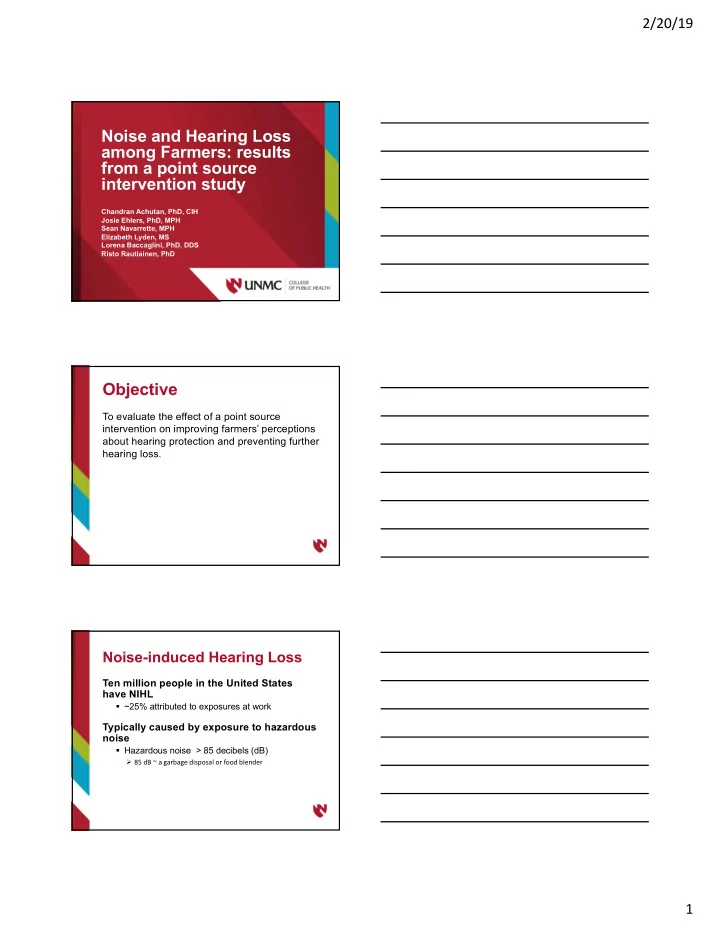

2/20/19 Noise and Hearing Loss among Farmers: results from a point source intervention study Chandran Achutan, PhD, CIH Josie Ehlers, PhD, MPH Sean Navarrette, MPH Elizabeth Lyden, MS Lorena Baccaglini, PhD, DDS Risto Rautiainen, PhD Objective To evaluate the effect of a point source intervention on improving farmers’ perceptions about hearing protection and preventing further hearing loss. Noise-induced Hearing Loss Ten million people in the United States have NIHL § ~25% attributed to exposures at work Typically caused by exposure to hazardous noise § Hazardous noise > 85 decibels (dB) Ø 85 dB ~ a garbage disposal or food blender 1
2/20/19 Hearing Loss and Farmers 11% of agricultural workers in the US have NIHL Farmers have third highest prevalence of NIHL Exposures to hazardous noise: § Tractors and combines 2,4-5 § ATV 2,5 § Equipment (sprayers, chainsaws, carts, dryers) 2,4 § Livestock 7 § Recreational Activities (firearms, concerts, vehicles) 6,9-10 Prevention is Key NIHL is permanent, but preventable Hazard recognized, but PPE use low § <50% use hearing protection Challenges for farmers § Little oversight § Limited resources § Logistic barriers Point Source Intervention Weather proof box containing § Ear muffs § 30-pairs of earplugs 2
2/20/19 Methodology Study Design § Cluster randomized controlled trial Ø Intervention arm (25 farms; 53 farmers) - Point source intervention and education Ø Control arm (26 farms; 36 farmers) - Education only § Data collected annually Ø BHPHL Questionnaire 16-17 - Beliefs about Hearing Protection and Hearing Loss Ø Audiometric test data - Conducted onsite at each farm - Ambient noise Study Population At a glance… § N=89 (79 men and 10 women) § Mean Age 49.8-years (SD 16.5 years; Range 17-90 years) Ø Control farmers about 12 years older § Most soybean and corn farmers § 46% involved in animal husbandry (cattle) § N=2 farmers with profound hearing loss Ø Excluded from hearing analyses 3
2/20/19 Statistical Analysis Pure-tone Audiometry on Farms: Mobile Testing Without a Sound-Treated Environment § Descriptive statistics Effect of a Point Source Intervention of Farmers’ Hearing § Generalized Linear Mixed Model (GLMM) Significance Level Two-Sided α=0.05 Onsite Audiometric Testing 278 audiometric tests administered § Basement, dining room, kitchen, shed, office, utility room, workshop, office at university Ambient noise minimized § Turning off lights § Unplugging appliances § Restarting tests Ambient Noise Thresholds American National Standard Institute § Maximum Permissible Ambient Noise Levels for Audiometric Test Rooms (ANSI MPANL) Occupational Safety and Health Administration § Maximum Allowable Octave-Band Sound Pressure Level (OSHA MAOSPL) 4
2/20/19 Results Most exceedances at 500 and 1000 Hz § ANSI MPANL exceeded more than OSHA MAOSPL Ø Most exceedances < 5 dB Hearing loss identified in unsuitable environments § 4000 Hz (3% exceeded) Ø 1/89 left and 2/89 right ears with hearing loss Results Baseline Hearing Acuity Bolded line indicates threshold for normal hearing (≤ 25 dB) Results Notches identified at 3, 4, and 6 kHz § Most identified at 4 kHz § Mean notch depth ~20 dB § Left ears had more evidence of NIHL Ø More notches and deeper notches 5
2/20/19 High-Frequency PTA High-frequency Pure-Tone Average (PTA) § Average hearing thresholds at 3, 4, and 6 kHz As farmers aged, their high-frequency PTA hearing thresholds increased (p<0.01) Left ears had greater high-frequency PTA than right ears (p<0.01) Ø Left ears = 30.35 dB* and right ears = 26.38 dB* *Model adjusted means Conclusion The educational component of the study was highly effective at changing farmers’ perceptions about hearing protection. The intervention may have been successful at preventing hearing loss, but more time was needed to appreciate those changes fully. Acknowledgement This study was supported by a grant from the National Institute for Occupational Safety and Health (U54 OH010162) 6
Recommend
More recommend